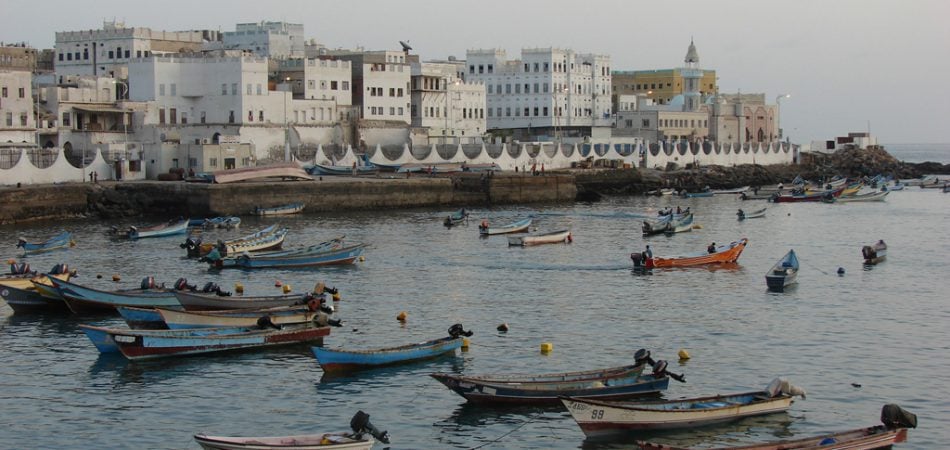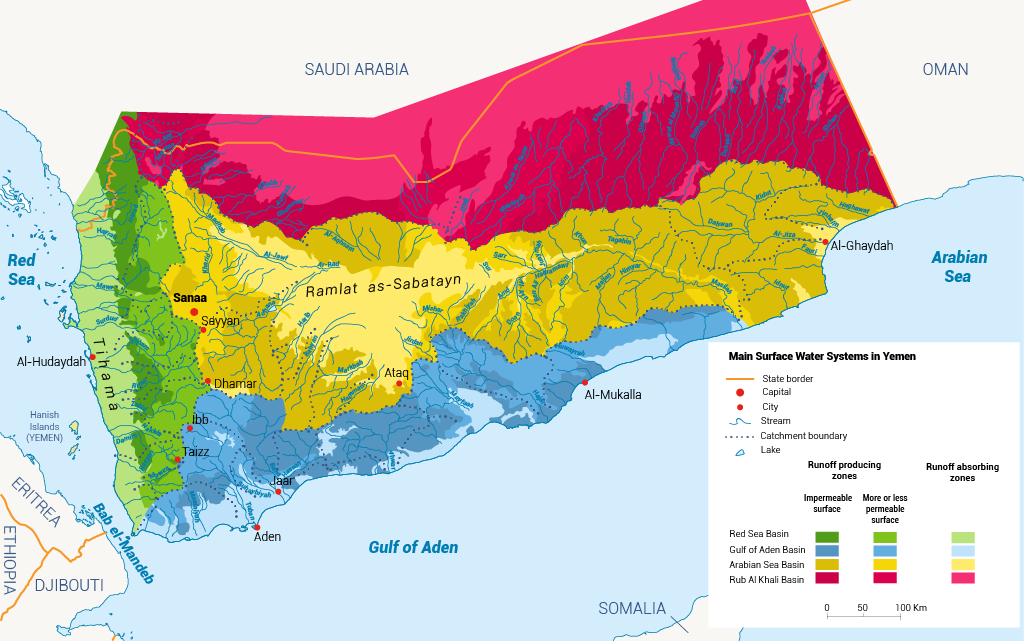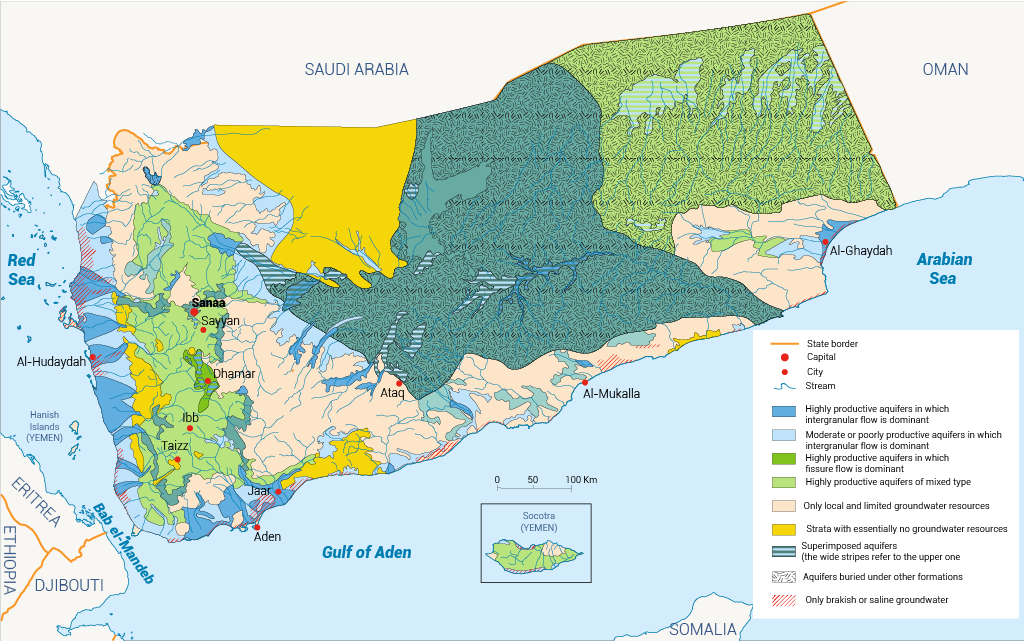
Besides having one of the highest population growth rates in the world, Yemen also has the highest rate of exhaustion of water resources in the Middle East. Sanaa is the only capital city that may run out of water within the next decade. The combination of high population growth and exhaustion of water resources has contributed to a water crisis that may be one of the most catastrophic the world has ever seen.[1]
Surface water
Surface water is an important source for irrigation. Surface water consists of seasonal spate water and springs, with differing quantity and quality depending on the area. Surface water resources are estimated to be about 1,000 MCM/yr, but this quantity corresponds to the runoff from major wadis and does not include the runoff produced within the smaller catchments. Assuming natural flow conditions, the base level of a drainage basin is either the sea or a topographic depression where massive evaporation takes place as the main natural discharge mechanism.
Accordingly, Yemen can be subdivided into four main drainage basins: The Red Sea basin, the Gulf of Aden basin, the Arabian Sea basin and the Rub al-Khali basin (Map 1). The runoff coefficient is additionally affected by at least two human-induced factors, namely the extensive terracing of the mountain slopes and the widespread use of rainfall harvesting techniques, which are widely practiced on mountain slopes to meet either domestic or irrigation water needs. These two factors are actually inter-related since terracing by itself may be considered a rainfall harvesting technique.[2]

Groundwater
Renewable groundwater is estimated to be 1,500 MCM/yr, which comes predominantly from infiltration in the main wadi beds. The annual water demand for domestic and industrial use and agricultural consumption is currently 3,900 MCM/yr, which far exceeds the renewable resource from both surface water and groundwater of 2,500 MCM/yr. Overall, the water availability is only 80 m3/capita/yr, which is well below the World Bank’s water poverty level of 1,000 m3/capita/yr. As in many other countries in the region, agriculture is by far the biggest consumer of over 3,060 MCM/yr, or 90% of total water use. Most of the water is withdrawn from groundwater – springs, wells, boreholes – and this has led to serious groundwater depletion as withdrawals far exceed annual groundwater recharge.[3]
Map 2 demonstrates the diversity of aquifer systems across the country and the variation in hydrogeological conditions that have led to a wide range of groundwater development systems. Highly productive aquifers exist along the coast in alluvial-filled wadis and in the fans and deltas created by the continuous process of flooding and sedimentation. Important aquifers exist in the Tihama plain, Tuban Abyan, Ahwar and Maiah in the south, Ramlat as-Sabatayn in the west and Wadi Hadhramawt in the east.
In the highland plains are the important sedimentary aquifers in Sa’adah, Amran, Sanaa, Mabar-Dhamar and the Rada basins. They have good transmissivity and favourable recharge conditions. In the east are the Mukalla sandstones, which constitute the largest aquifer complex in Yemen with moderate productivity that continues over into Saudi Arabia and Oman.

Non-conventional sources
Desalination
Up to now there are two desalination stations in Yemen, one of which is located in Aden called Al-Haswah Electricity Station. This station used to supply electricity mainly for Aden city through the heating of seawater, producing about 69000 m3 /day of freshwater. This amount of water is mixed with the network of Aden water supply. The second desalination station is under construction and is located in Al-Mokha area 100 km south of Taiz governorate. This station is constructed by private sector (Hail Saeed Group). In 2002, the total installed gross desalination capacity (design capacity) was 76 596 m3 /day or 28 million m3 /year (Wangnick Consulting, 2002). The production of desalinated water reached 25.1 MCM in 2006.
In many places in the country, brackish water appears naturally either in surface water or in groundwater. However, the extensive withdrawal of groundwater caused to increase the salinity in many basins particularly in the coastal areas. The actual brackish water quantity has not been identified over all the country. However, the usable brackish water for agriculture in Yemen is about 300 MCM/year and mostly in the coastal areas particularly in Tehama region. On the other hand, the amount of brackish water used in the water supply for Taiz city is about 3.1 MCM/year.[4]
Desalinating water for use as a possible future source is one of the proposed solutions to prevent Yemen’s water crisis reaching catastrophic levels. Accordingly, extensive studies around desalination, which is the conversion of seawater into drinkable water, would be useful to provide water to populations living near the coast. However, desalination is expensive, and the costs would raise the price of water for the population as a whole, potentially making it unaffordable.[5]
Wastewater reuse
Grey water refers to wastewater derived from bathtubs, showers, handbasins, washing machines, kitchen sinks and ablution basins in mosques. The results of a study of grey water samples that were collected weekly from mosques in Sanaa for quality determination showed that the chemical and physical properties, nitrate (NO3), ammonia (NH3), phosphate (PO4) and total suspended solids (TSS) were within the acceptable limits for water reuse in irrigation. On the other hand, the results showed the microbial and biological qualities of the grey water faecal coliforms (FC), biological oxygen demand (BOD5) and chemical oxygen demand (COD) were higher than the permissible levels for irrigation purposes.[6]
Wastewater quantity
Different wastewater treatment technologies are applied in Yemen, ranging from the most sophisticated type of extended aeration activated sludge systems to the simplest waste stabilization ponds. There are more than 17 main urban and more than 15 small rural wastewater treatment plants in operation, and the total flow of the treated wastewater is around 300,000 m3 per day, or around 100 MCM/yr. The amount produced has exceeded the design capacity of plants in places such as Sanaa and Ibb while others, as in Aden, are still underdesigned . The BOD of the influent is characterized out of the range of the known characteristics in the world, which was anticipated due to the water scarcity. A 2005 study showed that the BOD increased significantly in Sanaa from 550 milligrams per litre (mg/L) in 1985 to 800 mg/L in 1992 and reached 1,100 mg/L in 2000-2004.[7]
Wastewater quality
Influent BOD ranges from 1,000-1,200 mg/L in mountainous cities such as Sanaa, with the average being 500-700 mg/L in coastal cities. The quality of the effluent varies from one treatment plant to another, being good quality in Hajjah with a BOD of 30-50 mg/L [8] ), to very bad in Sanaa with a BOD of 291 mg/L.[9] In areas with poor-quality effluent, farmers are less willing to accept wastewater for irrigation.[10] In a recent field study that piloted alfalfa and squash cultivation using alternative irrigation sources (groundwater and raw or treated wastewater), it was found that the total and faecal coliforms attached to the crops were significantly lower, suggesting alternate irrigation could be a viable way to add fertilizer and decrease pollution at the same time.[11]
Rainwater harvesting
Rainwater harvesting aims to prevent as much rainfall as possible from being wasted. The government has constructed many small water harvesting and diversion structures to collect rainwater for irrigation and domestic use. These structures could either recharge the groundwater or be used as surface water. It is much easier and more effective to use surface water than to drill and pump groundwater.[12] The Social Fund for Development and the Public Work Project are both implementing hundreds of additional rainwater harvesting structures all over Yemen, either as open structures or covered structures, especially in rural areas but also in urban areas such as Sanaa, enabling the harvesting of storm water from streets or smaller amounts from the roofs of houses and schools [13]; [14] . In recent research at Sanaa University’s Water and Environment Centre, [15] looked at the viability of water harvesting along the Sanaa to Hodeidah road where water rights, water ponding and water structures are the main issues considered for irrigation.
Total water availability and per capita availability
Water availability is decreasing every year. The World Bank reported that in 1990, 71% of the population had access to water. In 2010, that figure had decreased to 65%. Per capita water availability is the lowest in the region and the world. The per capita share of water resources 80 m3 per annum – is very low compared with the global average of 2,500 m3, or even with the regional average of 1,000 m3. Total annual renewable water resources are estimated at 2.5 BCM (1.5 BCM of groundwater and 1 BCM of surface water). Total annual consumption, however, stands at 3.4 BCM. This means that 0.9 BCM of groundwater is being depleted every year, with a concurrent lowering of the water tables in most aquifers, ranging between 2-6 metres a year. Consequently, precious groundwater resources are expected to run dry within the next 15-50 years.[16]
[1] Wikipedia (based on UN data), n.d. List of countries by population growth rate.
[2] FAO, 2018. Yemen Plan of Action 2018-2020.
[3] FAO, 2019. Yemen Famine Prevention Plan. January-June 2019.
[4] ACWUA, 2010. Wastewater Reuse in Arab Countries.
[5] Glass N, 2010. ‘The water crisis in Yemen: Causes, consequences and solutions’. Global Majority E-Journal 1(1):17-30.
[6] Al-Tawqi A et al., 2018. Reuse of wastewater from Sanaa WWTP through planting. Water and Environment Centre, Science. www. Wec.edu.ye
[7] Al-Nozaily F. A., Khidhr F. and Salah A. I. (2006). Evaluation of Sana’a wastewater treatment plant. Journal of Science and Technology, Vol 11 (2006): Issue 2 (https://ust.edu/ojs/index.php/JST/issue/view/56)
[8] Ibid.
[9] Ibid.
[10] ACWUA, 2010. Wastewater Reuse in Arab Countries.
[11] Al-Tawqi A et al., 2018. Reuse of wastewater from Sanaa WWTP through planting, Sanaa University. Water and Environment Centre, www. Wec.edu.ye
[12] Van Steenbergen F et al., 2010. Guidelines on spate irrigation. FAO Irrigation and Drainage Paper 65.
[13] SFD yearly report 2017; https://sfd-yemen.org
[14] PWP yearly report 2018; http://www.pwpyemen.org/index.php/en/
[15] Al-Maswari, A.; Saleh, Sh.; Al-Nozaily, F. (in prep) Rain Water Harvesting Potential from Roads in Yemen, its social and economic benefits on national scale, A case study: Sana’a Al-Hodiedah Road – Yemen
[16] The World Bank, 2017. Yemen population growth (annual %).
